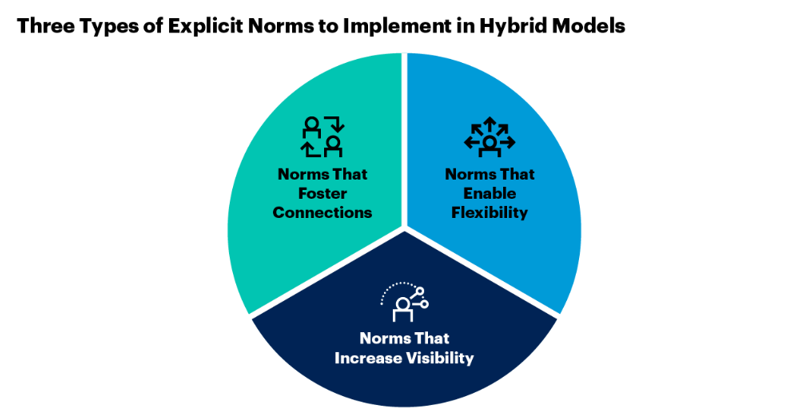Organisations that lack explicit norms around hybrid work can increase the likelihood of an employee leaving by 12%, according to Gartner. The company says that current hybrid work models lack the informal channels for absorbing norms that are present in an office setting. As more formalised hybrid work models are developed, leaders can reduce friction and increase engagement by establishing and communicating new norms more intentionally and explicitly.
► Successful hybrid models encompass three main categories of explicit norms to increase visibility, enable flexibility, and foster connections
► Gartner research found that the most successful hybrid models encompass three main categories of explicit norms (see Figure 1): those that increase visibility, enable flexibility, and foster connections

Source: Gartner (April 2023)
Increasing visibility
Creating transparency around work preferences provides an opportunity for employees to co-create team policies, such as when to focus and how to best communicate with one another. Schedule visibility and shared work preferences can improve employee performance, engagement and inclusion in a hybrid model. However, less than half of organisations are implementing these practices.
Progressive organisations build dedicated time to revisit and update work preferences into everyone’s schedule
Employees whose hybrid teams share work preferences can experience 8% higher engagement, a 7% higher sense of inclusion and 5% higher performance compared to employees whose teams do not, according to a Gartner survey of 3,524 employees conducted from October 2022 to November 2022.
‘Sharing work preferences should not be a static, one-time occurrence as work preferences evolve over time and with team staffing changes,’ said Caitlin Duffy, director in the Gartner HR practice. ‘Progressive organisations build dedicated time to revisit and update work preferences into everyone’s schedule, and any newly created teams or projects begin with a review of all members’ work preferences.’
Enabling flexibility
Frequent remote working days and meeting-free days have emerged as hybrid work norms that contribute to improved employee productivity and performance. While 55% of organisations are offering frequent remote days, only 22% of organisations have meeting-free days, according to the Gartner survey.
Remote working days give employees more autonomy over their work and personal lives to schedule activities and commitments in accordance with what works best for them. Gartner analysis found that the best hybrid models offer three or more remote days per week, on average.
Setting meeting-free days enables employees to customise their work structures, reduce virtual overload and stem meeting fatigue. While easier to implement than increasing remote-work days, meeting-free days still generate improved performance and engagement by creating room in employees’ workflows for deep focus time, reflection, innovation, creativity, rest and personal needs.
Fostering connections
Concerns about organisational culture have led some organisations to implement hybrid models that heavily favour on-site work or a full return to office. Gartner research shows that rather than implement rigid return-to-office mandates, organisations can improve employee outcomes by facilitating periodic in-person meetings and on-site work with managers. Yet only 40% of organisations are implementing either of these methods.
Organisations should avoid implementing policies that require employees to be on-site while managers can work remotely
In addition to conducting impactful in-person meetings for relevant milestones – regular in-person goal setting and strategy planning meetings, kick-off meetings for signature projects and annual team retreats – progressive organisations embed a variety of in-person meetings in their annual calendars.
‘Beyond in-person meetings, working in person with a direct manager can allow a mutual understanding of goals and work preferences and deepen relationships, making on-site work more valuable,’ said Duffy. ‘Organisations should avoid implementing policies that require employees to be on-site while managers can work remotely, as this will foster disappointment and resentment in the workforce, which could ultimately lead to attrition.’


